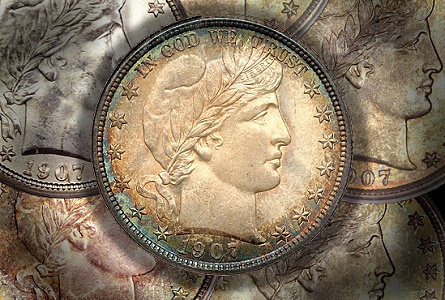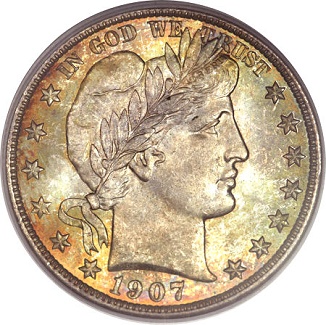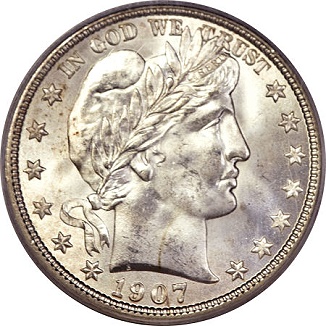A Weekly CoinWeek Column by Greg Reynolds
News and Analysis regarding scarce coins, coin markets, and the coin collecting community #163 …..
Barber Half Dollars were minted from 1892 to 1915. They were not struck at the Denver Mint until 1906. Each collector who would like to own a Denver Mint Barber Half Dollar should consider a 1907-D. In multiple grade and price ranges, attractive, naturally, toned 1907-D halves are not rare. Some of the gem quality coins are stunning. Many of the circulated pieces are very pleasing. One of the finest known 1907-D halves is ‘in the news’ as Heritage will soon offer Jim O’Neal’s 1907-D half, which is PCGS graded MS-67 on a scale from 01 to 70.
 The O’Neal 1907-D half is in the official auction of the CSNS Convention in Illinois, later this month. I have already written about other pieces that will be offered in this same auction, including the Garrett-Perschke Quint and various pieces from the epic collection of Eric Newman. (Clickable links are in blue.)
The O’Neal 1907-D half is in the official auction of the CSNS Convention in Illinois, later this month. I have already written about other pieces that will be offered in this same auction, including the Garrett-Perschke Quint and various pieces from the epic collection of Eric Newman. (Clickable links are in blue.)
The O’Neal 1907-D is in a relatively old PCGS holder, with a green label, and is CAC approved. I examined it in Jan. 2010, when Heritage auctioned it for $17,250. It is a terrific coin.
A few issues of Denver Mint Barber Halves, including 1907-D coins, cost less than $15 in Good-04 grade. A pleasing 1907-D in Fine-12 grade would retail for around $35, an attractive 1907-D in EF-40 grade may cost more than $200. The auction record for a 1907-D is $53,187.50, a price realized when Dale Friend’s set of Barber Halves was auctioned by Heritage in Jan. 2009 at a FUN Convention.
John Albanese likes 1907-D Barber Half Dollars. “They are great type coins; 07-D halves come nice. Many are bold and beautiful, with great luster. It is just a matter of finding one that does not have a lot of contact marks and abrasions. Some people prefer the 1907-D to the 1892 [Philadelphia Mint issue], which also comes really nice. Moreover, there are collectors who put together 20th century type sets. 1907-D halves tend to be pretty, for unknown reasons. I have seen pretty ones in various grades.” Albanese is the founder and president of the CAC.
I. What are Barber Half Dollars?
Like Barber Dimes and Barber Quarters, Barber Half Dollars were designed by Charles Barber. He was also the designer of Liberty Nickels, which are sometimes called ‘vee nickels.’ While the obverse (front) designs of Barber Dimes, Quarters and Halves are extremely similar, the obverse design of Liberty Nickels is much different from these. Barber silver coins were first struck in 1892. Liberty Nickels date from 1883 to 1913.
Barber Half Dollars were last minted in 1915. Walking Liberty Half Dollars were produced from 1916 to 1947, and Franklin Halves from 1948 to 1963. (Some believe that 1964 Franklin Halves exist, though I have never seen one or a picture of one.) The Kennedy Half Dollars of 1964 are 90% silver, as are most pre-1964 half dollars. Those dating from 1965 to 1970 are 40% silver. Kennedy Halves dating from 1971 to the present constitute another topic.
Barbers are much scarcer than Walkers Prices, however, for better date Barber Halves are similar to prices for better date Walkers, in several cases.
A set of Good-04 grade Barber Halves, including all dates (and corresponding mint locations), could be assembled for an amount between $2200 and $3200. Seventy-three dates, including coins struck at four U.S. Mint locations, are needed for a complete set.
Barber Halves in EF-40 grade are good values, in my view, provided that the buyer selects coins that score highly in the category of originality, with pleasant natural toning. Please see last week’s article for a discussion of the notion that many, terrific, classic U.S. coins are not expensive.
A terrific year set, which is sometimes called a “date set,” of EF-40 grade Barber Halves could cost less than $6000! A complete set, with all dates (including all mint locations) of EF-40 grade Barber Halves, with natural toning and choice surfaces, may cost slightly more than $30,000.
A ‘D’ mintmark is found on Denver Mint coins, and New Orleans Mint coins each have an ‘O’ mintmark. The 1892 ‘Micro O’ variety is usually ignored. While it is curious that the ‘O’ on representatives of this variety is markedly small, an 1892 ‘Micro O’ half is not a logical choice for a budget-minded collector. An 1892 with a regular ‘O’ is expensive enough, as it is one of the better dates in the series.
The 1904 San Francisco Mint issue is the key ‘date’ in the series. San Francisco Mint Barber Halves feature an ‘S’ mintmark. Before 1980, no Philadelphia Mint half dollar was struck with a mintmark.
Rather than put together a whole set of Barber Halves or buy just one for a type set, a collector may wish to consider an expanded type set that includes one of each of the four mints that produced Barber Half Dollars. It is not expensive to acquire Philadelphia, Denver, New Orleans and San Francisco Mint Barber Halves.
The 1907-D is among the least scarce in the whole series. The estimate on PCGS CoinFacts that just five thousand survive ‘in all grades’ is hard to believe. Most experts are under the impression that there exist at least eight thousand 1907-D halves, including those that are non-gradable. Many 1907-D halves, however, have been dipped or have ‘not so pleasant’ toning.
There must be more than two hundred that are terrific. It should not take too much time to find a particularly appealing 1907-D, for a reasonable price, in the grade range of the buyer’s choice.
II. The Jim O’Neal Type Set
The PCGS graded, and CAC approved, MS-67 1907-D that will be auctioned this month is part of Jim O’Neal’s type set. In terms of type sets of copper, nickel and silver business strikes from 1793 to 1964, O’Neal’s set is third on the “All-Time” list in the PCGS set registry. In the set registry category of silver-only U.S. type sets of business strikes, O’Neal’s entry is number two.
 Apparently, O’Neal is selling a type set that is oddly incomplete. O’Neal’s collection of type coins is missing three types of Liberty Seated Dimes and a ‘No Motto’ Liberty Seated Quarter, which are not rare as type coins. If all of O’Neal’s type coins have really been entered into the PCGS registry, he is also missing a bust dollar with a Heraldic Eagle reverse (back) design, among several other types of silver coins.
Apparently, O’Neal is selling a type set that is oddly incomplete. O’Neal’s collection of type coins is missing three types of Liberty Seated Dimes and a ‘No Motto’ Liberty Seated Quarter, which are not rare as type coins. If all of O’Neal’s type coins have really been entered into the PCGS registry, he is also missing a bust dollar with a Heraldic Eagle reverse (back) design, among several other types of silver coins.
I wonder, though, if the listings in the PCGS registry are really revealing of O’Neal’s entire collection of type coins. In 2007, he consigned a set of Indian Head Half Eagles ($5 gold pieces) to auction, and O’Neal did not then publicly reveal that he had another set of Indian Head Half Eagles, which turned out to be better than the set that was auctioned in 2007. O’Neal’s epic set of Indian Head Half Eagles was sold during the Jan. 2011 FUN Platinum Night event in Tampa.
In the Jan. 2009 Platinum Night event, O’Neal’s set of Indian Head Eagles ($10 coins) was sold. Though both sets were ranked at the top in their respective registry categories, sophisticated collectors were much more impressed with his Half Eagles. These certainly were more impressive in terms of originality.
Many other type coins from O’Neal’s set are being offered in this CSNS auction in April. In 2005, Heritage auctioned O’Neal’s collection of paper money. He has been a collector for many years and was formerly a board member of Collectors Universe, the parent company of the PCGS.
III. Finest Known 1907-D Halves
There never will be widescale agreement as to which 1907-D half is the finest known. Among those that have been publicly offered in recent decades, the three finest are very close in terms of quality. These are the Duckor-Friend piece, the Pittman coin and the soon to be offered O’Neal 1907-D.
 The Hugon Collection, dipped white 1907-D that is represented, perhaps accurately, as having earlier been in the Eliasberg Collection. It is PCGS graded “MS-67.” Recently, Heritage offered it in Aug. 2011 and, again, in Aug. 2012.
The Hugon Collection, dipped white 1907-D that is represented, perhaps accurately, as having earlier been in the Eliasberg Collection. It is PCGS graded “MS-67.” Recently, Heritage offered it in Aug. 2011 and, again, in Aug. 2012.
Years ago, before he returned to work as a grader for the PCGS, I discussed this coin with Charlie Browne. He consulted his Eliasberg catalog of April 1997, in which Charlie noted that he graded the Eliasberg piece as ‘MS-67’ in 1997.
Browne did not have nearly as positive a view of the Hugon piece in 2005. If these two are really the same coin, someone dipped the Eliasberg 1907-D and it now, in Charlie’s view, is of lower quality than it was before it was dipped. For more than three decades, Browne has been considered one of the foremost graders in the nation.
In 1997, the cataloger (QDB?) of the Eliasberg 1907-D refers to it as a “lustrous, frosty specimen with delicate splashes of magenta and blue, an artistic and aesthetic delight!” The Hugon 1907-D that Charlie and I examined in Jan. 2005 did not have any magenta or blue tones.
Even after considering that such dipped silver coins are accepted in rare coin markets, the Hugon 1907-D, even if it is the Eliasberg piece, grades 66+ at most, in the opinions of some relevant experts. Should it have been certified as grading MS-67? In March 2007, Stack’s auctioned this certified MS-67 grade Hugon 1907-D for $12,650, an amount well below the price range for a true MS-67 grade 1907-D at the time.
 The Duckor-Friend piece has the most attractive obverse (front) of any 1907-D half that I have ever seen. There are, though, some faint hairlines on the face, and a few noticeable contact marks in the field near the nose. When Dale Friend’s set was auctioned on Jan. 8, 2009 in Orlando, Dr. Duckor bought this coin for the astounding amount of $53,187.50. In 2010, it became one of the few Barber Half Dollars, or maybe the only one, on which Dr. Duckor incurred a significant loss. On Aug. 11, 2010, it brought $29,900, when Dr. Duckor’s set was sold in Boston.
The Duckor-Friend piece has the most attractive obverse (front) of any 1907-D half that I have ever seen. There are, though, some faint hairlines on the face, and a few noticeable contact marks in the field near the nose. When Dale Friend’s set was auctioned on Jan. 8, 2009 in Orlando, Dr. Duckor bought this coin for the astounding amount of $53,187.50. In 2010, it became one of the few Barber Half Dollars, or maybe the only one, on which Dr. Duckor incurred a significant loss. On Aug. 11, 2010, it brought $29,900, when Dr. Duckor’s set was sold in Boston.
Before Jan. 2009, the Duckor-Friend 1907-D was PCGS graded MS-67. Early in 2010, when Dr. Duckor’s set was re-submitted to the PCGS under the then new SecurePlus program, this coin was re-certified as “MS-67+.”
Although the Duckor-Friend 1907-D is a stunning coin, its grade does not seem to be in the high end of the 67 range. There are too many imperfections. The indentations near the nose and eye are bothersome.The reverse (back) is not quite as attractive as the obverse, though the reverse is nearly flawless in a technical sense. Overall, the Duckor-Friend coin grades in the middle of the 67 range.
 The Pittman 1907-D is “a coin of extraordinary quality and beauty. It is by far the finest and prettiest Barber Half Dollar in the John Jay Pittman Collection,” asserts David Akers in the catalog of the Pittman II sale, on page 121.
The Pittman 1907-D is “a coin of extraordinary quality and beauty. It is by far the finest and prettiest Barber Half Dollar in the John Jay Pittman Collection,” asserts David Akers in the catalog of the Pittman II sale, on page 121.
The Pittman 1907-D grades in the middle of the 67 range, too, in the views of several experts. The obverse (front) of the Pittman piece, by itself, truly grades 67+ or even 68! That obverse is virtually flawless and is really neat, with creamy inner fields along with blues and green tones near the periphery. I remember seeing the Pittman 1907-D in May 1998 before it had ever been certified. Honestly , I then wrote ‘67 mid range’ in my notes, with the obverse being “67+”!
The reverse is very attractive though not nearly in the same league as the obverse. The Pittman 1907-D has been NGC graded MS-68. Reliable sources suggest that it has been submitted to the PCGS on several occasions and graders at the PCGS have always refused to grade it as MS-68. I understand, though, why some experts do grade it as MS-68. In my view, it is just not exciting enough or spectacular enough to merit a 68 grade. In terms of technical issues and originality, it fulfills some criteria for a 68; its eye appeal does not quite reach the 68 level.
Actually, the reverse of the O’Neal 1907-D merits a 68 grade, though the grade of the obverse is not close to the 68 level. The overall grade of it, too, is in the middle of the 67 range. Because of the marked discrepancy in quality between the obverse and the reverse of the O’Neal 1907-D, I could understand why some collectors would choose the Pittman or Duckor-Friend pieces over the O’Neal 1907-D, even though the O’Neal piece could very well be the finest known. Generally, the grade of the obverse counts for two-thirds of the overall grade of a coin, and thus the reverse counts for one-third. The reverse of the O’Neal 1907-D is amazing, as I remember from examining it in 2010.
The fact that the Pittman 1907-D bounced around for a long time is circumstantial evidence that many potential buyers do not grade it as MS-68. In auctions, the Goldbergs offered it in Sept. 2003 and in Feb. 2007. Superior Galleries offered in August 2006. A coin firm in Delaware had it during much of the middle of the last decade, and attempted to sell it at major conventions. Furthermore, the Pittman 1907-D appeared in several ANR or Stack’s auctions, including those of Jan. 10, 2005, July 10, 2008, Oct. 22, 2008, Jan. 12, 2009, and July 30, 2009.
On July 10, 2008, when markets for rare U.S. coins were just about to peak, it is said to have been successfully auctioned for “$29,900.” A widely acclaimed MS-68 grade 1907-D, if one exists, would then have been worth at least $40,000, maybe even as much as $70,000.
In sum, all three of these grade in the middle of the 67 range. Though the Pittman piece is probably the finest known, the obverse of the Duckor-Friend 1907-D and the reverse of the O’Neal 1907-D are much more exciting than either side of the Pittman coin. Indeed, the colors on the Duckor-Friend 1907-D are far neater in actuality than they appear to be in images.
Although the reverse is much more exciting, the obverse of the O’Neal 1907-D is very much alive, too. It really glistens. This coin sold for just $17,250 in Jan. 2010, a weak price. It is likely to realize more this month.
©2013 Greg Reynolds





I think you are way off in your price of an EF-40 set of barber halves. I will take any EF-40 set you have at $6K…..other than that, very nice article
David,
I appreciate your interest in my articles. I am grateful that you pointed out an incorrectly formulated sentence. As you probably figured out, I meant to say that a complete set ‘by year,’ which is sometimes called ‘a date set,’ could be built for less than $6000. It is true that a complete set, with all dates (including mint locations) of EF-40 grade Barber Halves, with pleasant natural toning and choice surfaces, may cost slightly more than $30,000, an amount that is a good deal for a truly complete set of terrific coins of a classic series. In any case, I have clarified the matter. In the future, when you find any statements that are not completely accurate or are unclear, please do not hesitate to comment or otherwise communicate.
Thanks, Greg
your right…..unfortunately there is no store that can you offer you that set…..it would take years to complete
I have never been crazy about Barber coin designs. I think after this article, I’ll have to add some high grade Barber half dollars to my collection of silver halves, just to represent that era. Great article. It was like art history. The more I learn about a subject (in this case a coin), the more I can appreciate it, even if I don’t personally like it.